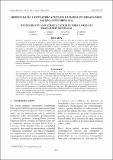Por favor, use este identificador para citar o enlazar este ítem:
https://hdl.handle.net/20.500.12958/4044Registro completo de metadatos
| Campo DC | Valor | Lengua/Idioma |
|---|---|---|
| dc.contributor.author | Quispe, J. | - |
| dc.contributor.author | Vásquez, L. | - |
| dc.contributor.author | García, W. | - |
| dc.contributor.author | Morón, O. | - |
| dc.contributor.author | Pizarro, L. | - |
| dc.contributor.author | Flores, G. | - |
| dc.contributor.author | Sánchez, S. | - |
| dc.contributor.author | Flores, R. | - |
| dc.date.accessioned | 2022-04-25T17:27:18Z | - |
| dc.date.available | 2022-04-25T17:27:18Z | - |
| dc.date.issued | 2022-03 | - |
| dc.identifier.citation | Quispe J., Vásquez L., García, W., Morón O., Pizarro L., Flores G., Sánchez S., Flores R. 2022. Hidrografía y estratificación en la bahía de Miraflores. Marzo-setiembre 2014. Inf Inst Mar Perú. 49(1): 122-136. | es_ES |
| dc.identifier.issn | 0378-7702 | - |
| dc.identifier.uri | https://hdl.handle.net/20.500.12958/4044 | - |
| dc.description.abstract | Con datos hidrográficos de dos prospecciones, realizadas en marzo y setiembre 2014, se describe la hidrografía y estratificación en la bahía de Miraflores (BM) asociadas a condiciones cálidas y frías en ambos periodos. En marzo se presentó una condición estratificada y cálida, con máximos valores de frecuencia de Brunt Väisälä (FBV) y de vorticidad potencial (VP); asimismo la termoclina, haloclina y picnoclina fueron pronunciadas, debido principalmente a la mayor radiación solar recibida. En setiembre, la columna de agua fue más homogénea y fría con presencia de una capa de mezcla débil y somera. La distribución de la temperatura potencial, salinidad y densidad potencial tuvo una relación directa con la estacionalidad y con la configuración de la bahía en el aspecto espacial. Se espera que los resultados obtenidos en el presente estudio contribuyan a un conocimiento más completo de la oceanografía costera de la región, principalmente de la bahía de Miraflores. | es_ES |
| dc.description.abstract | ABSTRACT: Based on hydrographic data from two surveys, conducted in March and September 2014, we describe the hydrography and stratification in Miraflores Bay (MB) associated with warm and cold conditions during both periods. In March, there was a stratified and warm condition, with maximum values of Brunt-Väisälä frequency (BVF) and potential vorticity (PV). Likewise, the thermocline, halocline, and pycnocline were noticeable, mainly due to the higher solar radiation received. In September, the water column was more homogeneous and colder with the presence of a weak and shallow mixing layer. The distribution of potential temperature, salinity, and potential density had a direct relationship with seasonality and with the spatial configuration of the bay. We expect that our results will contribute to a more complete knowledge of the coastal oceanography of the region, mainly in Miraflores Bay. | - |
| dc.language | spa | - |
| dc.language.iso | spa | es_ES |
| dc.publisher | Instituto del Mar del Perú | es_ES |
| dc.relation.ispartofseries | Informe IMARPE 49(1), 2022; | - |
| dc.rights | info:eu-repo/semantics/openAccess | es_ES |
| dc.rights.uri | https://creativecommons.org/licenses/by/4.0/ | es_ES |
| dc.source | Instituto del Mar del Perú - IMARPE | es_ES |
| dc.source.uri | Repositorio Digital IMARPE | es_ES |
| dc.subject | Estratificación | es_ES |
| dc.subject | Hidrografía | es_ES |
| dc.subject | Mecanismos físicos | es_ES |
| dc.title | Hidrografía y estratificación en la bahía de Miraflores. Marzo-setiembre 2014 | es_ES |
| dc.title.alternative | Hydrography and stratification in Miraflores Bay (March-September 2014) | - |
| dc.type | info:eu-repo/semantics/article | es_ES |
| dc.publisher.country | Perú - Callao | es_ES |
| dc.subject.ocde | http://purl.org/pe-repo/ocde/ford#1.06.12 | es_ES |
| Aparece en las colecciones: | Informe vol. 49(1) 2022 | |
Ficheros en este ítem:
| Fichero | Descripción | Tamaño | Formato | |
|---|---|---|---|---|
| Informe 49-1 artículo7.pdf | 4,36 MB | Adobe PDF |  Visualizar/Abrir |
Este ítem está sujeto a una licencia Creative Commons Licencia Creative Commons

